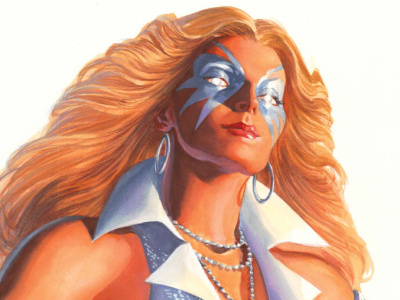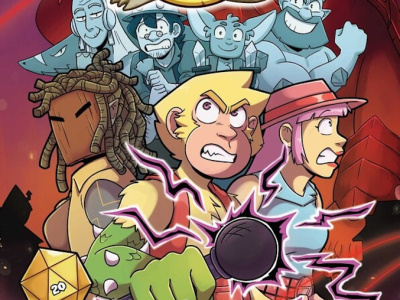What are you seeing in the manga market over the last year?
Richardson: For us in 2014, we’ve published more books than we did in 2013. I just saw the number. This year we’re increasing once again. We have announcements coming up. We intend to increase.
You know we were never hit as hard as a lot of the publishers in the manga downturn. First of all a lot of our manga sells in the comic shops as opposed to the book stores. The bookstores is where the biggest pain was felt. I think we lost a lot of market share in manga that we’ve never recovered, particularly when Borders went down because Borders was a big distribution channel for us for our manga. They sold a lot of our manga there, and when they disappeared I don’t think that we’ve ever recouped that particular market.
Although, now we’re seeing some nice increases over about a year in the bookstores and manga sales. We’ve seen a noticeable increase, some surprising increases. So I think manga’s coming back, and we generally publish a certain kind of manga that probably looks different than the other manga publishers. Books like the New Lone Wolf and Cub, and it’s not like we’re not publishing competing projects, obviously we are when we’re publishing books [from creators] like CLAMP, but we tend to be not so focused on the shojo and other areas that the other publishers focus on.
NOTE: Horn provided the following information after the interview:
2014 -- 33 frontlist manga titles released / 52 backlist manga titles reprinted
2013 -- 26 frontlist manga titles released / 25 backlist manga titles reprinted
As you can see, new manga releases from DH were up more than 25% between 2014 and 2013, whereas reprints of manga titles more than doubled in that same period.
Is the mix changing between shojo and shonen?
Horn: Obviously the Japanese books that we release are made in Japan and over the years they change because they reflect the developing trends that happen creatively in Japan. One of the things that happened over the last 20 or 30 years in Japan is that shojo began to influence the other demographics in manga. If you look at some of the bestselling manga in the United States, titles like Black Butler and Attack on Titan, these are supposedly shonen titles. Essentially that’s the demographic, but they have a lot of female readers and that’s because they have developed titles which really have a style and an aesthetic that have something to offer both male and female readers.
I think that’s really an ideal kind of comics writing, if you could really reach everybody and have something that appeals to a wide range of people. So where shojo definitely had a strong ideological impact (because there was this idea women could make comics and not have to worry about anybody but female readers), its influence is even broader than that.
So the influence of shojo is not just titles that are only shojo. For example, look at Dark Horse’s CLAMP titles. Cardcaptor Sakura is a shojo title; however, Chobits is not a shojo title. It was technically made for a male audience, but being a CLAMP title, of course, it shows their tremendous shojo influence. That is really how you grow readership, you expand demographics by taking lessons and strengths that you learn from one type of appeal and bring them into another. That really helps to broaden the conversation and create more books that are more meaningful to more readers.
Gombos: Some of our best titles I feel have a strong female demographic (but people at Shueisha have noted that even in Japan half the readership of Shonen Jump is female).
Looking at some of our best books, Oreimo did really good for us. Hatsune Miku or Hatsune Mix has been on The New York Times bestseller for list eleven straight weeks now (see "New Video Game Another Opportunity for 'Miku' Merch"). We’ve gone back on press several times on that book. And then Mike also mentioned for 2013-2014 we saw about a 30% increase in new titles printed but also important to note was that we more than doubled our backlist titles reprinted.
Horn: And that’s because of our switch to Random House distribution, which really gives us the opportunity to reach a lot more people. We have a tremendous back catalogue. We’ve been publishing manga since 1988. We’re the second oldest manga publisher in the U.S., we would have been the oldest manga publisher in the U.S., always planned to publish manga. Mike, you discovered manga in the early 1970s, isn’t that right?
Richardson: Yeah, I actually have the original Action. That’s where I found Lone Wolf and Cub, that’s how I knew it-- before it was called Lone Wolf and Cub, we just knew it as the baby card series from the movies, which I knew evolved from the television series in Japan.
Horn: When we say “manga,” it’s a bit like saying “comics.” It doesn’t really tell you all that much. What’s the story genre? What’s the style? It’s tremendously diverse.
Richardson: What it means is “Japanese comics.”
Horn: But it’s a whole universe of diversity and we are always looking for good titles. It could be titles of any type: this is interesting, the fans are going to like this. We’re not necessarily thinking in terms of demographics specifically saying this is definitely a shonen title or this is definitely a shojo title. Our ambition is to get readers and as we have said, the terms shonen and shojo, even in Japan are of somewhat limited use. Obviously the bestselling titles (that’s what everybody wants) are titles that appeal just as much to women as to men.
Horn: I believe we’re in our third or fourth printing but we’ve sold more than 20,000 copies of it.
NOTE: After the interview, Horn provided the following: We have to date sold 19,748 copies of Unofficial Hatsune Mix in the book market, and 3,730 in the comics market [around 23,500 total].
Richardson: It’s not the traditional $9.99 or $10.99 book.
Horn: It’s a $19.99 book.
Miku is like CLAMP in that it’s one of our passport titles. It gets us entry into readers who are not only not reading our manga core, they might not have heard of Dark Horse before, but are now that we’re bringing this character across.
And Miku is a very beloved character, as you say. In some ways she’s a very simple concept. She’s the opposite of--a lot of people say characters have to have a great back story--Miku doesn’t have a back story. There are only a few canon facts about her existence; everything else is created by the fans, sort of a crowdsourced sort of character. And that is part of the key to the fact that she’s so popular, because she is literally made up of the things that the fans would like her to be like. She’s really charming and it’s a very lighthearted story.
Hatsune Miku is a mix of all different types of short stories, but basically it’s a very enjoyable book and I just see the reaction on people’s faces when I go to conventions and events. They’ve heard of Miku and you see everyone walking around with long green ponytails. That’s really cool, so we’re glad to be a part of it. It’s not often that one of our characters is on David Lettermen, but I have to admit that Dave handled it in a very professional way. It’s hardly the strangest thing that’s ever been on his show.
Click here for Part 2.










